The Attacks on New Ulm
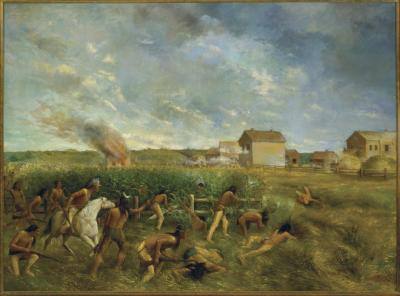
On the afternoon of August 19, 1862, New Ulm came under siege by a relatively small group of Dakota warriors. This skirmish lasted several hours and left five settlers dead. The following day the people of New Ulm elected Judge Charles Flandrau, a prominent citizen from St. Peter, as their military commander. Over the next few days more than 1,000 refugees ballooned New Ulm’s population to 2,000 people, while only 300 were equipped to fight.
The second battle of New Ulm took place on August 23. This time, however, more than 600 Dakota soldiers fought, under the guidance of Chiefs Waƞbdiṭanka, Wabaṡa, and Makato. This was the largest battle over a US town since 1776.
After fending off an attack on August 25th, Charles Flandreau led the evacuation of about 2,000 residents of New Ulm and outlying areas to Mankato, St. Peter, and St. Paul. Mankato and St. Peter became ad hoc refugee camps. As people crowded into hastily assembled lodgings, diseases spread like wildfire.
Children were left orphaned, with no social-service agencies in place to see to their needs. Widows struggled to maintain homes and farmsteads.
"The procession from New Ulm has arrived, & was nearly four miles long--the sight beggared description. 1500 or 2000 people carrying upon their backs all of their Earthly goods.
Hungry, tired, & lame.
My heart sickens at the sight--& aches at our inability to furnish the base necessaries of life. We have filled ev'ry building in town excepting the best Residences, with tens and hundreds & still there are perhaps a thousand in the streets with no covering but the canopy of Heaven. . . .
We have all, & more than we can do. If the State Authorities do not come to our relief, God only knows what will become of us all. . . .
We have Established Soup-houses & Bakeries, & done Everything that the people here can do--We are taking everything in the town regardless of ownership, but it will only hold out a few days."
Letter from Albert Knight, St. Peter, to his wife in St. Paul, August 27, 1862. Source: Minnesota Historical Society Archives.
Theme:
1862Permissions beyond the scope of this license may be available at Copyright and Use Information.
Bibliography
Fridley, Russell W., and Charles E. Flandrau. Charles E. Flandrau and the Defense of New Ulm. New Ulm: Brown County Historical Society, 1962
Resources for Further Research
Websites
150th Anniversary of the U.S. - Dakota War of 1862. Brown County Historical Society, New Ulm, Minnesota.
Primary
Fridley, Russell W., and Charles E. Flandrau. Charles E. Flandrau and the Defense of New Ulm. New Ulm: Brown County Historical Society, 1962
Key People
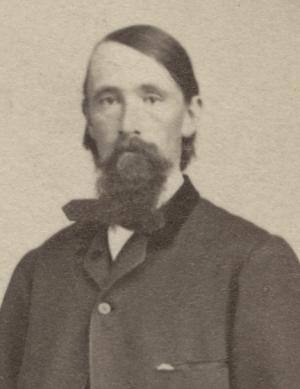
Charles Flandreau
“Their advance upon the sloping prairie in the bright sunlight was a very fine spectacle, and to such inexperienced soldiers as we all were, intensely exciting.”
Charles Flandreau
On the afternoon of August 19, 1862, New Ulm came under siege by a relatively small group of Dakota warriors. This skirmish lasted several hours and left five settlers dead. The following day the people of New Ulm elected Judge Charles Flandrau, a prominent citizen from St. Peter, as their military commander. Over the next few days more than 1,000 refugees ballooned New Ulm’s population to 2,000 people, while only 300 were equipped to fight.
The second battle of New Ulm took place on August 23. This time, however, more than 600 Dakota soldiers fought, under the guidance of Chiefs Waƞbdiṭanka, Wabaṡa, and Makato. This was the largest battle over a US town since 1776. After holding off the attack, Charles Flandrau led the evacuation of New Ulm on August 25, leaving much of the city in ashes.
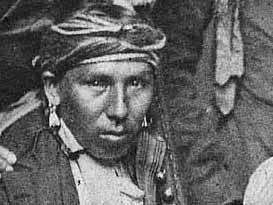
Makato
Born about 1822, Mankato was the son of Good Road, for whose family the village "Mankato" was named. The Blue Earth River takes its name from the Dakota phrase "Makato Osa Watapa," or "the river where blue earth is gathered."
Mankato was a member of the delegation who signed the Treaty with the Dakota on June 19, 1858. He appears (left) in the famous photograph of the treaty signers made at a photography studio in Washington, D.C. During the U.S.-Dakota War he led a band of Mdewakanton soldiers into battle at Fort Ridgely, Birch Coulee, and Wood Lake. On September 23, 1862, he was killed by a cannonball at the battle of Wood Lake.
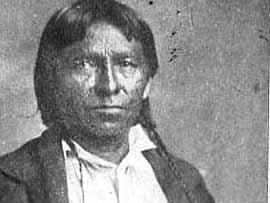
Wabaṡa
"We think our Great Father may have forgotten his Red children & our hearts are very heavy — the Agents he send to us seem to forget their father’s words before they reach here for we often think they disobey what he has said. . . . You have said you are sorry to see my young men engaged still in their foolish dances--it is because their hearts are sick. They don’t know that whether these lands are to be their home or not."
Wabaṡa to Bishop Whipple, 1862
Chief Wabaṡa (also known as Wabasha, Wapasha, or Tahtapesaah), a member of the Mdewakanton band of Dakota, lived on a farm on the Lower Reservation by the Agency. During the U.S.-Dakota War, there were divisions between groups of Dakota people who were for or against the fighting. Wabaṡa joined a group of Dakota called the Peace Party whose aim was to bring people to safety.
After the war, Wabaṡa was exiled to Crow Creek in South Dakota, and later to Santee, Nebraska.
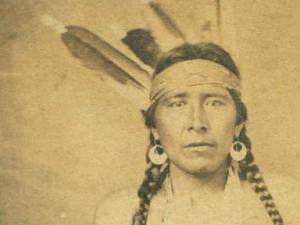
Wambditanka (Big Eagle)
"There was great dissatisfaction among the Indians over many things the whites did. The whites would not let them go to war against their enemies. . . . Then the whites were always trying to make the Indians give up their life and live like white men--go to farming, work hard as they did--and the Indians did not know how to do that, and did not want to anyway. It seemed too sudden to make such a change. If the Indians had tried to make the whites live like them, the whites would have resisted, and it was the same way with many Indians. The Indians wanted to live as they did before the treaty of Traverse des Sioux--go where they pleased and when they pleased, hunt game wherever they could find it, sell their furs to the traders and live as they could."
Wambditanka (Big Eagle), Mdewakanton Dakota leader, in an interview conducted with journalist Return I. Holcombe in 1894
Also known as Jerome Big Eagle, Wambditanka was born in 1827 at Black Dog’s village, a few miles above Mendota on the south bank of the Minnesota River. He succeeded his father, Grey Iron, as chief in 1857. By 1858 had moved to the Redwood (Lower Sioux) Agency to farm. When war broke out he joined the fighting and was at the battles of New Ulm, Fort Ridgely, Birch Coulee, and Wood Lake. After the war he was tried and convicted by the military commission, but received a pardon from President Lincoln in 1864. After several years living on reservations, Wambditanka and his family returned to Minnesota where he lived until 1906.
On the war of 1862:
"It began to be whispered about that now would be a good time to go to war with the whites and get back the lands. It was believed that the men who had enlisted [to fight in the Civil War] last had all left the state, and that before help could be sent the Indians could clean out the country, and that the Winnebagoes [Ho-Chunk], and even the Chippewas [Ojibwe], would assist the Sioux. It was also thought that a war with the whites would cause the Sioux to forget the troubles among themselves and enable many of them to pay off some old scores. Though I took part in the war, I was against it. I knew there was no good cause for it, and I had been to Washington and knew the power of the whites and that they would finally conquer us. We might succeed for a time, but we would be overpowered and defeated at last. I said all this and many more things to my people, but many of my own bands were against me, and some of the other chiefs put words in their mouths to say to me."
"I did not have a very large band. . . . Most of them were not for the war at first, but nearly all got into it at last. A great many members of the other bands were like my men; they took no part in the first movements, but afterwards did. . . . When I returned to my village that day I found that many of my band had changed their minds about the war, and wanted to go into it. . . . I was still of the belief that it was not best, but I thought I must go with my band and my nation, and I said to my men that I would lead them into the war, and we would all act like brave Dakotas and do the best we could. All my men were with me; none had gone off on raids, but we did not have guns for all at first."
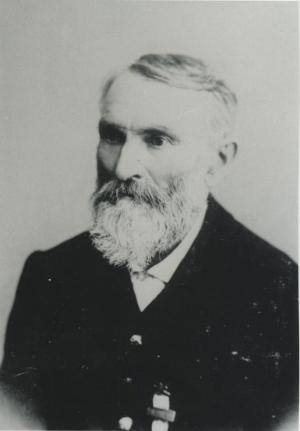
Jacob Nix
Jacob Nix was an immigrant from Bingen on the Rhine, Germany.
When the revolution of the German states broke out in 1848, Nix joined the struggle and became a captain in the “Free Corps.” Sentenced to death for treason, Nix escaped to the United States and in 1858 settled in New Ulm and opened a general store.
Due to his previous military experience, Nix was appointed commander of the New Ulm forces when the Dakota War broke out. He successfully defended the town during the first onslaught. After the war, Nix joined the Union army and participated in punitive expeditions.
From The Sioux Uprising in Minnesota, 1862 : Jacob Nix's Eyewitness History:
"One should not, of course, have provoked the Indians with injustices, but they also should not have made the inhabitants of an entire region pay for the wrongs committed by specific individuals by murdering, burning, and scorching the earth, and attacking settlers, destroying everything -- men and women, old people and children -- which came before their rifles and bows and arrows. Then, of course, there suddenly appeared the fanatics who immediately took up the cause of the captured red murderers after the defeat of the uprising. The following momentous words from the Bible should have been cast before these crazy, hypocritical puritans: An eye for an eye! A tooth for a tooth! That means: Immediately after the capture of the red scoundrels, one should not have wasted any time in shooting or hanging every one who took part in the horrible crimes which occurred in the summer of 1862 in Minnesota."
Contemporary Comment:
"If it wasn’t for Captain Nix, I wouldn’t be alive today, because Grandma refused to leave the farm. . . . He heard about the Uprising occurring, and that it got to New Ulm. So he came back and dragged her out of the house. She wouldn’t go. He said: ‘You can stay here, but I’m taking the kids.’ She finally went along with it, reluctantly."
Richard Runck, oral history, New Ulm, 2011
Related Images

Musket
This musket was used by Captain Louis Buggert who led a Brown County militia unit and was killed in the second battle of New Ulm on August 23rd, 1862.
Related Documents
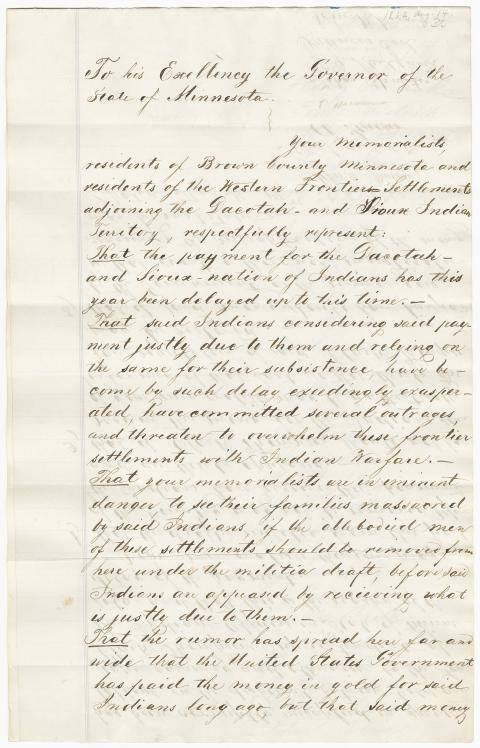

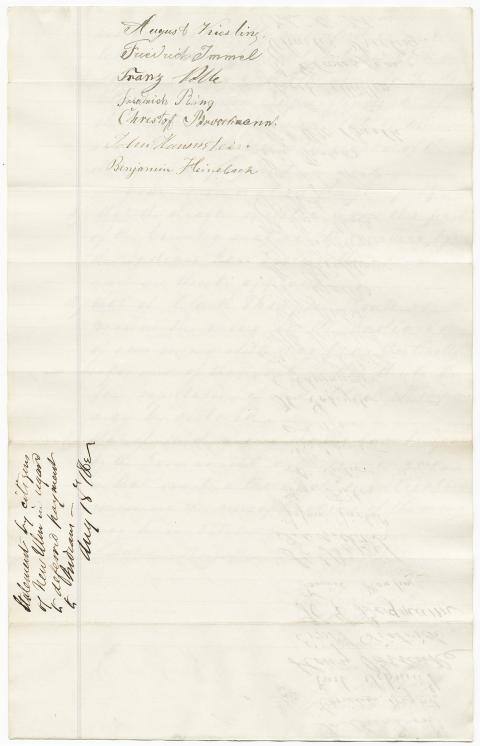
New Ulm Petition
On August 14, a group of New Ulm residents voiced their concerns in a strongly worded petition sent to Minnesota governor Alexander Ramsey. In it, the settlers described delays in payments to the Dakota, rumors of corruption in the state's office of Indian Affairs, and their fears that a war was imminent. An excerpt of their letter reflects the level of panic, fueled by fact and rumor, running rampant before the war.
That the payment for the Dacotah and Sioux nation of Indians has this year been delayed up to this time. That said Indians considering said payment justly due to them and relying on the same for their subsistence, have become by such delay exceedingly exasperated, have committed several outrages and threaten to overwhelm these frontier settlements with Indian Warfare. That your memorialists are in eminent danger to see their families massacred by said Indians, if the able bodied men of these settlements should be removed from here under the militia draft, before said Indians are appeased by receiving what is justly due them. That the rumor has spread here far and wide that the United States Government has paid the money in gold for said Indians long ago, but that said money has been corruptly misapplied in speculations on the discount between gold and paper currency and otherwise by the Hon. Clark Thompson, Superintendent of the Indian Affairs in the State of Minnesota, and that this is the reason of the delay of the payment. Dated August 14th, A. D. 1862 Of the 47 signers of this petition, two (Johan Schneider and Ernst Dietrich) were killed on August 18. A third (G. W. Otto Barth) was wounded August 23 and died shortly after. Signers: John G. Rudolph John Manderfelt(d) A. Strecker L. Brockmann Johan Schneider D. G. Shillock Francis Erd John W. Young F. Beinhorn Christian Prignitz Carl Schmidt Henry Behnke Ernst Dietrich H. C. Bergmann ? Martin S.C.? Johan Bobleter Johan ? Aug. Friton Stu Seiter P. Scherer C. Pfau H. Loheyde C. Schumacher Fr. Rehfeld H. Schalk Fr. Wehrs W. Galles H. Kiesling ? Kiseling Pet. Jos. Schmitz P. Hitz Joseph Hitz Louis Theobald G. W. Otto Barth Charles Roos Jacob Muller A. Claussen Charles Frieberg John C. Toberer August Kiesling Fredrich Immel Franz Nolle Friedrich Ring Christoff Brockmann John Hauenstein Benjamin Heinebach
